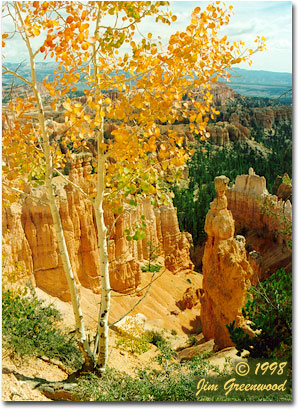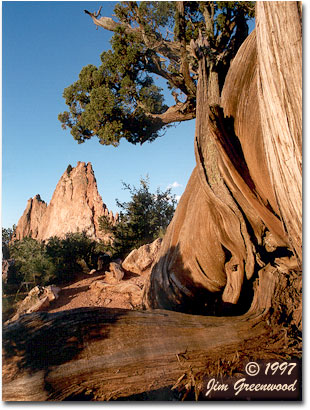|
|
 A Tree is More Than a Tree
Text (except as noted) and photography Copyright Jim Greenwood One of my favorite subjects to photograph is trees. For any landscape photographer, trees are quite naturally the subject or a significant element of many photographs. However, in the interest of brevity, I will narrow the scope to a discussion of photographs in which a single tree or a very small group of trees are the primary or secondary element. An individual tree can be an object of exceptional beauty and soul. A solitary picturesque tree can by itself be the subject or primary element of a great photograph. As a secondary element of a scene, a beautiful tree or a small group of trees can also transform what might otherwise be just another ordinary photograph into an extraordinary image by adding interest as well as depth and perspective. Of course, the reverse is also true. Just as a tree can make a great photograph, it can also break a great photograph. As a result of poor shot composure, or a lack of attention to details within the scene, the tree or trees can draw excessive interest away from the primary subject of a photograph, or even completely overwhelm the subject. One common detail which is overlooked at times is wind speed. When your shot includes trees with leaves, especially at close range, and the wind is blowing, you'll need to set the shutter speed fast enough to freeze the motion of the leaves. Also, trees often tend to blend into a scene more than expected in a two-dimensional photograph, compared to the three-dimensional world in which we live. This is especially true when there isn't much tonal variation in the scene, or the light is flat, or when the light is very bright and the scene lacks depth. I can't deny that I've taken many such photographs, thinking they would be really great shots, only to have been disappointed when I viewed the product of my effort. But I've also taken many good photographs of or including trees as well, and maybe even a few great ones. "I never saw a discontented tree. They grip the ground as though they liked it, and though fast rooted they travel about as far as we do." - John Muir
When I think of the Rocky Mountains, one of the first things that comes to mind is the quaking aspen. I was very surprised to learn that the quaking aspen (species Populus tremuloides) is actually the most wide-ranging tree in North America. Another variety, the European aspen (species Populus tremula), is found throughout Europe, northern Africa, western Asia, Siberia, northeastern Asia and China. The aspen is the second most widely distributed tree in the world. Not only is the quaking aspen found throughout the Rockies from Mexico to Alaska, but they also range throughout most of Canada, as well as most of the northern United States. They grow at elevations from between sea level in its eastern range to as high as 11,500 feet in the southern Rockies. The photograph at the right is of Thor's Hammer, one of the more recognizable formations in Bryce Canyon National Park. Including the pair of young aspens in the foreground, displaying their autumn foliage, makes this image more interesting by giving it greater depth, and by adding color to the upper half of the photograph. I especially like the similarity of the golden-yellow color of the leaves and the warm golden morning glow of the canyon below. The quaking aspen's wide range is due primarily to its ability to adapt to different environments, its dual method of reproduction, and its high rate of growth. Aspens reproduce both by seed, and by vegetative cloning. Cloning is by far the most common method in the sub-alpine climate of the Rockies and the arid climate of the high desert and canyons of the Colorado Plateau. Clones sprout from the roots of the parent tree, usually following a natural or man-made disturbance such as fire, avalanche or logging. A grove of cloned aspens can become very large in number. One in Utah contains more than 47,000 clones. Other astounding examples have been found which contain more than 110,000 clones in a single acre. Technically, a cloned community of aspens is actually a single tree, and these extreme examples may well be the largest living organisms on Earth. "Trees are sanctuaries. Whoever knows how to speak to them, whoever knows how to listen to them, can learn the truth. They do not preach learning and precepts, they preach undeterred by particulars, the ancient law of life." - Hermann Hesse, Wandering
Many years ago, during his campaign for governor of California in 1965, Ronald Reagan made this rather amusing remark after being informed of plans to expand the Redwood National Park. Well, I'd have to disagree, especially when it comes to landscape photography. The more trees you look at, and include conscientiously in your shot selection, the more likely you will be to get superior results. So look at those trees! Don't just pass them by. Study a tree's locale and surroundings in order to choose the best vantage point that will help you create a better photograph. Look between and under its branches. Get down in the dirt at ground level if that's where the best shot is. Get to know it. Make that tree your friend and you'll have a friend for life! Jim Greenwood - NPN 013 Comments on this article? Send them to the editor. |
|
|
 I always make a conscious effort to observe and be aware of trees while hiking, or anytime I'm doing landscape photography. Having spent the most time to date in pursuit of both of those activities in the mountains and high deserts of the southwestern United States, two of the tree varieties to which I've devoted a lot of attention are the aspen and the juniper.
I always make a conscious effort to observe and be aware of trees while hiking, or anytime I'm doing landscape photography. Having spent the most time to date in pursuit of both of those activities in the mountains and high deserts of the southwestern United States, two of the tree varieties to which I've devoted a lot of attention are the aspen and the juniper. There are many different species of juniper. They, along with the pinyon pine, are of such significance in the southwest, that an ecosystem has been named in their honor, appropriately known as the pinyon-juniper woodlands. The one-seed juniper (species Juniperus monosperma) is very common throughout southern Colorado, Arizona, New Mexico, western Texas, and northern Mexico at elevations of between about 3000-8000 feet. Its foliage and berries are vital food sources for a large variety of wildlife ranging from mule deer and bighorn sheep to numerous species of birds. The one-seed juniper is a very slow growing tree, but it can live for over one thousand years. It is characterized by twisted, gnarled, skeletal trunks, especially at advanced age, when it can be particularly photogenic.
There are many different species of juniper. They, along with the pinyon pine, are of such significance in the southwest, that an ecosystem has been named in their honor, appropriately known as the pinyon-juniper woodlands. The one-seed juniper (species Juniperus monosperma) is very common throughout southern Colorado, Arizona, New Mexico, western Texas, and northern Mexico at elevations of between about 3000-8000 feet. Its foliage and berries are vital food sources for a large variety of wildlife ranging from mule deer and bighorn sheep to numerous species of birds. The one-seed juniper is a very slow growing tree, but it can live for over one thousand years. It is characterized by twisted, gnarled, skeletal trunks, especially at advanced age, when it can be particularly photogenic.